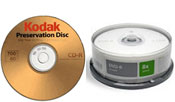Resource Guide Homepage
Resource Guide Homepage
Reference/Exhibition Formats
DVD (Digital Video Disc) is among the preferred formats for exhibiting single-channel works in a gallery or museum environment. DVD, introduced in 1995, is an optical disc storage technology that shares the same overall dimensions of a CD but has a much greater storage capacity. It uses MPEG2 compression to encode 720:480p resolution and full-motion video, and Dolby Digital to encode 5.1 channels of discrete audio. This also makes DVD an option for the exhibition of works with up to 5.1 channels of surround-sound. DVD is not a failsafe medium; there are a number of important considerations to keep in mind. There is an enormous quality spectrum when it comes to DVD authoring. A poorly encoded DVD will result in image and sound fraught with digital artifacts, unwanted pauses, unpredictable interruptions, and distortions. It is critical to allow for ample time to test, and potentially replace, your exhibition copy prior to installation. Another important part of DVD authoring is the loop function. If the work is to be looped (repeated continuously throughout exhibition hours), the DVD should be programmed to accommodate this during authoring. There are many different manufacturers and types of DVD-R (recordable DVD) stock. The manufacturer and quality of your media stock will impact its compatibility with playback equipment and its overall reliability. Professional DVD players are designed to run continuously without failure. Most professional models have serial ports (RS-232) allowing computer control and synchronization of multiple DVD players and are also multi-standard, playing back both NTSC and PAL DVDs. DVD media is rapidly evolving. DVD-R Gold is a relatively new format which claims an archival life. These discs are considerably more expensive. In the near future HD-DVD and Blu-ray Disc will be available; these discs will have much greater storage capacity, and thus will accommodate video encoded at higher rates.
DVCAM (not to be confused with MiniDV, which most consumer camcorders use) is the preferred format for a cinematic or theatrical screening. Although it is of superior technical quality to DVD, DVCAM cannot be shown as an endless loop, and is thus less desirable for unattended gallery and museum exhibitions. Developed by Sony as part of the DV format and introduced in 1996, DVCAM transports tape 50 percent faster than DV (digital video) and MiniDV, resulting in a higher track width, which can store more information and result in a higher quality image. The codec used is the same as DV, but because of the greater track width available, the data is much more robust, resulting in 50% less dropout. DVCAM is a professional/industry-level product, and playback decks are designed for high quality playback, with many output options accommodating numerous cable configurations. If an artist?s master exists on DVCAM, a collector may be provided with a sub-master on DVCAM for archival purposes. This sub-master should not be used for general exhibition playback. An exhibition copy on a more suitable format should be provided.

